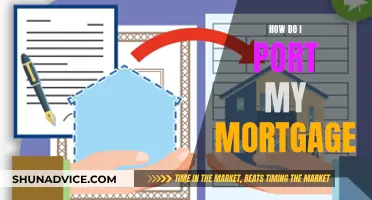
If you're looking to reduce your mortgage principal, there are several options available to you. Firstly, understand the concept of loan amortization, which is the reduction of debt over time. By making extra payments or larger payments, you can designate that the extra funds be applied to the principal, thereby reducing the interest you'll pay over time. Additionally, consider seeking a principal reduction, which is a decrease in the principal owed on a loan, typically offered by lenders to help homeowners avoid foreclosure. Principal reductions were more common after the 2008-2009 financial crisis but have become less common since the expiration of federal programs in 2016. Another option is to build up equity by staying in your home and making regular or extra payments. Alternatively, you can look into refinancing for a lower monthly payment or seek a loan modification, which changes the terms and conditions of your loan. Finally, consider the dollar-a-month strategy, where you increase your monthly payment by $1 each month, helping to reduce the term of your mortgage.
How to reduce mortgage principal
| Characteristics | Values |
|---|---|
| Recast | The process of making a large principal reduction and lowering monthly payments. Contact the lender before doing so as a fee may be incurred. |
| Extra Payments | Making extra payments towards the principal can reduce the loan term and the amount of interest paid. |
| Lump Sum Payments | Making a large payment can reduce the monthly payment. |
| Dollar-a-Month Strategy | Increasing monthly payments by a small amount, e.g. $1, can reduce the term of the mortgage. |
| Windfalls | Using windfalls such as bonuses, tax returns and credit card rewards to make extra payments. |
| Refinancing | Refinancing for a lower monthly payment can save money over the life of the loan. |
| Loan Modification | A loan modification changes the original terms and structure of the mortgage. |
| Principal Reduction Programs | Introduced by the US government following the 2008-2009 financial crisis to reduce the principal owed and keep homes out of foreclosure. |
What You'll Learn

Making extra payments
There are a few ways to make extra payments. You could increase your monthly payment by a small amount, such as $1 a month, or a larger amount, such as $100 or $500. You could also make half-monthly payments every two weeks instead of one full monthly payment, which would be the equivalent of making one extra monthly payment per year. You could also pay off a lump sum, although you may incur a fee for doing so.
If you have a windfall, such as a holiday bonus, tax return or credit card reward, you could put this towards your mortgage. You could also use the proceeds from the sale of a house to pay down the principal on a new home.
Be sure to inform your lender that any extra payments should be applied to the principal, not the interest. You can request a recasting of the loan if you've paid enough of the principal down to make it worthwhile. This will lower your monthly payments.
Moving Your Mortgage: A Guide to Smooth Transitioning
You may want to see also

Requesting a recast of the loan
To be eligible for a recast, you must meet certain qualifications. Firstly, you cannot have a government-backed loan, such as an FHA, VA, or USDA loan. Secondly, most lenders require a minimum lump sum payment towards the principal, typically around $10,000, but this can vary, so check with your lender. This payment can be a percentage of your principal and does not always need to be a lump sum. Additionally, your lender may require a certain amount of equity in your home, and your loan must be in good standing, with a history of on-time payments.
A mortgage recast is a good option if you want to keep your current interest rate and have the cash to make a substantial lump-sum payment. It is also a more comfortable choice than refinancing, as it does not involve a credit check and continues with the original mortgage. Refinancing, on the other hand, means replacing your current mortgage with a new one, which can be costly and dependent on your credit standing.
It is important to note that not all lenders offer mortgage recasting, and not all types of mortgages are eligible for recasting. Additionally, making extra principal payments without recasting can also help you pay off your loan sooner, as you will be ahead of schedule with fewer mortgage payments remaining. However, your monthly payments will remain the same.
Strategies for Recasting Your Mortgage: A Guide
You may want to see also

Building equity
Make Regular Mortgage Payments
The foundation of building equity is making consistent monthly payments. Each payment reduces your outstanding loan balance, gradually increasing your ownership stake in the property. Initially, a large portion goes towards interest, but over time, more of your payment will be applied to the principal, increasing your equity.
Pay Extra Towards the Principal
Making extra payments towards the principal can dramatically reduce the length of your loan and save you money in interest payments. Ensure to inform your lender that any extra payments should be applied to the principal to avoid defaulting to future scheduled monthly payments.
Increase Your Down Payment
The bigger the down payment, the more home equity you start with. A larger down payment can also help you avoid private mortgage insurance (PMI), making your monthly payments more manageable.
Enhance Your Property
Making strategic home improvements can increase the functionality and appeal of your property, thereby boosting its value. Focus on upgrades that align with current market trends and neighborhood standards, such as updating your kitchen or living room.
Boost Rental Income
If you're renting out your property, ensuring you're charging market-rate rent can help build equity. The rent you receive can then be used to pay down your mortgage.
Recast Your Mortgage
If you've made significant progress in paying down your principal, you may be able to recast your mortgage. This process involves resetting the remaining principal balance to be paid off over the remaining life of the loan, resulting in lower monthly payments.
By implementing these strategies, you can effectively build equity in your home, increasing your net worth and creating a valuable asset over time.
Generate Mortgage Leads: Strategies for Success
You may want to see also

Refinancing for a lower monthly payment
If you're looking to reduce your monthly mortgage payments, refinancing is an option. Here are some ways to lower your monthly mortgage payment through refinancing:
Refinance to a fixed-rate mortgage
If you currently have an adjustable-rate mortgage (ARM), refinancing to a fixed-rate mortgage can provide financial security by eliminating the uncertainty of fluctuating payments. While the monthly savings may not be significant, you'll benefit from consistent monthly payments and protection from future rate increases.
Streamline Refinance
A Streamline Refinance is available for many FHA, VA, and USDA loans. This option typically allows lenders to forgo re-checking income, credit, or employment, resulting in a quicker closing process with less paperwork. You may also be able to skip the home appraisal, making refinancing possible even with little or no home equity.
Cancelling Mortgage Insurance Premiums
If you're paying private mortgage insurance (PMI) or FHA mortgage insurance premium (MIP), it could be adding a significant amount to your monthly payment. Cancelling these premiums is a way to lower your total monthly payment. If you have at least 20% equity in your home, you can request your lender to remove PMI. Similarly, if you refinance your FHA loan into a conventional loan and have at least 20% equity, you can avoid both MIP and PMI.
Extend your loan term
If you have a 15-year mortgage, refinancing to a 30-year mortgage can reduce your monthly payments and provide some financial relief. While this will result in paying more interest over the life of the loan, it can be a good option if you're facing financial constraints. You can always make additional payments down the line if your income increases or you receive unexpected windfalls.
Shop for affordable homeowner's insurance
Homeowner's insurance premiums tend to rise annually, but you're not required to stick with your current carrier. Shopping around for insurance can help you find the same coverage at a lower price, reducing your overall monthly housing expenses.
Recording a Mortgage in QuickBooks: A Step-by-Step Guide
You may want to see also

Seeking a loan modification
To qualify for a loan modification, you'll typically need to meet certain requirements, such as providing proof of significant financial hardship, demonstrating that you're behind on your mortgage payments, and ensuring that the property is your primary residence. It's important to note that loan modifications are generally available for government-backed loans, as private lenders may be less willing to modify the terms.
When seeking a loan modification, you must contact your mortgage lender or servicer and provide the necessary documentation to demonstrate your financial situation. They will evaluate your application and determine if you are eligible for a modification. If approved, the modification will result in a permanent change to your existing mortgage, reducing your monthly payments to a more affordable level.
While a loan modification can help you stay in your home and avoid foreclosure, it's important to consider the potential drawbacks. Loan modifications may increase your long-term borrowing costs, and there is a possibility of a negative impact on your credit score. Additionally, if the modification includes principal reduction, the IRS may treat the forgiven debt as taxable income, which should be reported on your tax return.
It's always a good idea to explore all your options and carefully evaluate the potential consequences before making any decisions regarding your mortgage. Consulting with a financial advisor or seeking guidance from a government-backed loan program can help you navigate the process and make the best choice for your specific circumstances.
Reaffirming Your Mortgage: Post-Bankruptcy Steps to Take
You may want to see also
Frequently asked questions
Principal reduction is a decrease in the principal owed on a loan, typically a mortgage. Lenders often grant homeowners a principal reduction to help them avoid foreclosure.
Principal reductions are typically granted to homeowners with negative equity (owing more on your home than what it’s worth).
Alternatives to principal reduction include interest rate reduction, refinancing for a lower monthly payment, and seeking out a loan modification.
Paying extra towards your principal can be a great way to lessen the time it takes to repay your loans and the amount of interest you’ll pay. Making half-monthly payments every 2 weeks, instead of one full monthly payment, is another way to pay down your mortgage in less time.
Contact your lender to see if you are eligible for a lower monthly payment.







